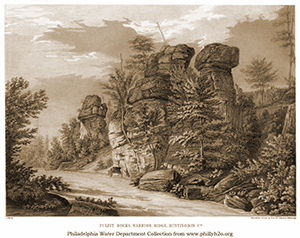 |
||||||||||
|
||||||||||
Early Settlers in Shaver's Creek Valley |
||||||||||
Barree, West and Logan Townships, |
||||||||||
|
Shaver's Creek is a tributary of the Juniata River in Huntingdon County, Pennsylvania. It was named for Indian trader, Peter Shaver, who settled on the west side of Shaver's creek about 1754. He was found decapitated near his home and his head was never recovered. Shaver's Creek Manor was reserved by the proprietaries of the province for their own use. The warrant for its survey was dated October 30, 1760. A warrant to John McNitt date August 31, 1787, was for land improved in June, 1760. In the warrant to James Childs, granted August 2, 1762, for the tract of land lying on the creek above Fairfield, it is described as being about ten miles from the mouth of Shaver's Creek, and known by a globe painted on a tree by an Indian. The stream entering the creek within the lines of this survey evidently derives its name, GLOBE RUN, from the circumstance. In 1763, Samuel Finley applied for land on Shaver's Creek, "next below the Globe." On June 8, 1763, William Wilson applied for a warrant for two hundred acres, "to include his improvements on the west side of Shaver's Creek." James and John Dickey settled near Shavers' creek about 1764. John mentioned improvement made three years before in his application No 3119, dated March 23, 1767, for three hundred acres. Barree Township was created from Cumberland County in 1767. The name was originally written Barré. Old Bedford County was made from part of Cumberland County, in 1771. Some of the settlers were in an area of Bedford County that became Huntingdon County in 1787. West Barree was formed from Barree in 1796. Jackson Township was formed from Barree in 1845. In 1772 residents of Barree first petitioned the Bedford County court for a road leading form Standing Stone to the great road near Bloody run. In 1784, William Long, Jr. was residing on a tract, which was improved in the fall of 1774. In 1775 a tax assesment was made in Barree Township, which was then in Bedford County. In 1776 William McLevy, Alexander McCormick, James Williams, Abraham Haines, Robert Smith and Nathaniel Jarrard [Gerard?] were chosen to lay out needed roads. During the Revolution, settlers from the area were in the 3rd Battalion which was formed in 1777 commanded by William McAlevy. It also included men from Frankstown and Hopewell. Early settlers found protection in blockhouse forts. When an alarm was raised, women and children were taken to the fort. McAlevy's blockhouse fort was on a bluff east of the village on a bank of Standing Stone Creek. It was built in 1778 on the border of Barree and Jackson Townships. In 1778 there was a failed Tory plot in Barree Township. Crum's blockhouse fort was built in 1780 and was a refuge for settlers in Stone Valley. Peter Crum leased a mill from the Minor brothers on a branch of the Little Juniata. Peter was killed by indigenous warriors in 1781. McCormick's blockhouse fort was on Stone Creek. Rickett's blockhouse fort was located about between Saulsburg and Manor Hill. In 1781 a tax assesment was made in Barree Township which was then in Bedford County. In 1785 a tax assessment was made in Barree Township which was then in Bedford County. In 1787 part of Bedford County, including Barree Township became part of Huntingdon County. In 1788 Robert Smith made a tax assesment list for Barree. At that time it was in Huntingdon County. Some of the residents also appeared on the Logan and West tax list. In 1788, John Little was captain of the militia in Huntingdon County. His company was made up of men from Barree. In August, 1788, the settlers were gathered at McCormick's fort. James McClees and Mrs. Huston left the fort to gather flax and were killed by indigenous people. In 1791 Arthur Bell was captain of the second company of the first battalion from Huntingdon Township. Many pioneers of Shaver's Creek Valley moved on to Ohio and Kentucky. Among the earliest settlers in the township were the Ewings, McMahons, Riddles, and Tolans, who settled in the northern part; the Ricketts, Hennens, and Murrays settled in the vicinity of Warrior Ridge in the southern part. Later came the Moores, Bells, Stewarts, McIlhennys, and Henrys, who settled in the central part.
|
|
||||||||
|
||||||||||
|
||||||||||
|
||||||||||
|
||||||||||
|
©Roberta Tuller 2025
|
||||||||||

